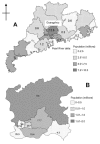Epidemiologic clues to SARS origin in China
- PMID: 15207054
- PMCID: PMC3323155
- DOI: 10.3201/eid1006.030852
Epidemiologic clues to SARS origin in China
Abstract
An epidemic of severe acute respiratory syndrome (SARS) began in Foshan municipality, Guangdong Province, China, in November 2002. We studied SARS case reports through April 30, 2003, including data from case investigations and a case series analysis of index cases. A total of 1,454 clinically confirmed cases (and 55 deaths) occurred; the epidemic peak was in the first week of February 2003. Healthcare workers accounted for 24% of cases. Clinical signs and symptoms differed between children (<18 years) and older persons (> or =65 years). Several observations support the hypothesis of a wild animal origin for SARS. Cases apparently occurred independently in at least five different municipalities; early case-patients were more likely than later patients to report living near a produce market (odds ratio undefined; lower 95% confidence interval 2.39) but not near a farm; and 9 (39%) of 23 early patients, including 6 who lived or worked in Foshan, were food handlers with probable animal contact.
Figures





References
-
- World Health Organization. WHO issues global alert about cases of atypical pneumonia: cases of severe respiratory illness may spread to hospital staff. Geneva. Organization. 2003; (March):12 Available from http://www.who.int/csr/sars/archive/2003_03_12/en/ Accessed January 21 2004.
Publication types
MeSH terms
LinkOut - more resources
Full Text Sources
Miscellaneous
